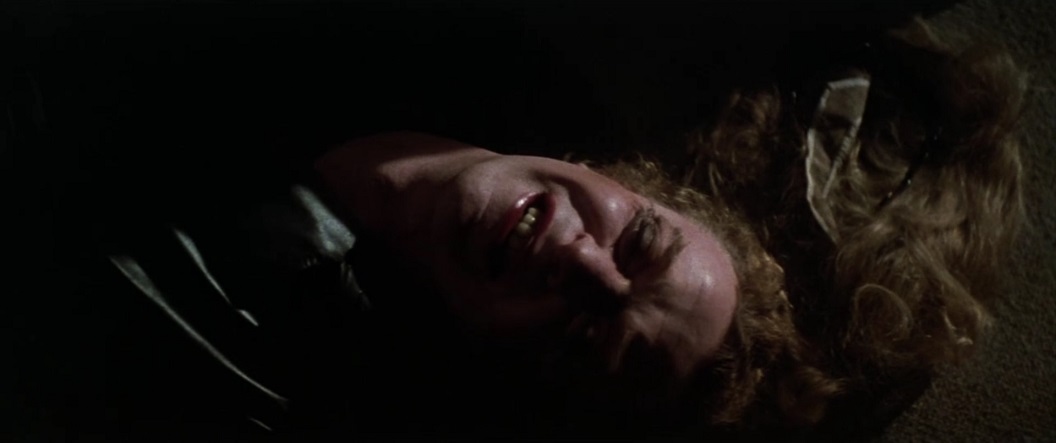JESSICA CRETS OFFERS A TRANS WOMAN'S DEEPER PERSPECTIVE ON CONTROVERSIAL THRILLER

While The Guardian's Scott Tobias looks at "Brian De Palma's thrilling yet problematic shocker," Dressed To Kill, as it turns 40, and Steve Erickson at The Quietus investigates why the film's legacy at 40 "feels knotty," Jessica Crets at Crooked Marquee looks at what she calls "the unintentional empathy of Brian De Palma’s Dressed to Kill."
"As a fan of De Palma and a trans woman," Crets states, "I’ve always struggled with this film. Over the years, a different portrait of the trans killer Bobbi began to emerge; each new viewing led me to believe there’s more empathy towards her than other critical readings have suggested." Crets feels that while "the film has some pop psychology gobbledygook about two sexes inhabiting the same body," De Palma nevertheless did his research. "Without meaning to, he crafted a story that actually tells us important things about the way trans people were treated in the late ‘70s."
Here's an excerpt from Crets' article:
In his 2015 Daily Beast piece on the Criterion release, writer Keith Phipps quotes trans woman film critic Alice Stoehr as noting, “Elliott’s pathology—‘opposite sexes inhabiting the same body’—bears minimal resemblance to the experiences of actual trans women. Instead, it reads as a conflation of trans identity with dissociative identity disorder. At its most hostile, Dressed To Kill suggests that trans women are dangerous, unstable, and confused. Whereas in Carrie, De Palma found truth by telling his monster’s story, here the monster is incomprehensible and alien.” This was one of the nicer quotes I found about the movie from other trans women, but you get the idea.As a fan of De Palma and a trans woman, I’ve always struggled with this film. Over the years, a different portrait of the trans killer Bobbi began to emerge; each new viewing led me to believe there’s more empathy towards her than other critical readings have suggested.
The film has some pop psychology gobbledygook about two sexes inhabiting the same body – that both Dr. Elliott and Bobbi, the trans woman, wanted control, and Dr. Elliot barred Bobbi’s transition. Liz asks Bobbi’s gender psychiatrist, Dr. Levy, about this: “You mean when Elliot got turned on, Bobbi took over?” Levy responds, “Yes, it was like Bobbi’s red alert. Elliot’s penis became erect and Bobbi took control, trying to kill anyone that made Elliot masculinely sexual.”
In the 1960s and 1970s, it was much harder for trans people to be able to transition in America. One would have to fit a very narrow criteria to be approved for the process. The Harry Benjamin International Gender Dysphoria Association, long one of America’s primary trans gatekeeping associations, described it this way in 2001:
During the 1960s and 1970s, clinicians used the term true transsexual. The true transsexual was thought to be a person with a characteristic path of atypical gender identity development that predicted an improved life from a treatment sequence that culminated in genital surgery. True transsexuals were thought to have: 1) cross-gender identifications that were consistently expressed behaviorally in childhood, adolescence, and adulthood; 2) minimal or no sexual arousal to cross-dressing; and 3) no heterosexual interest, relative to their anatomic sex… Belief in the true transsexual concept for males dissipated when it was realized that such patients were rarely encountered, and that some of the original true transsexuals had falsified their histories to make their stories match the earliest theories about the disorder.
An argument can be made that Dr. Elliott, who would have been familiar with these gatekeeping guidelines, would have found it impossible that he could be trans. Most of his profession would have believed this, which could have caused him to try to squash these desires. In fact, Dr. Elliot represents the psychiatric field’s gatekeeping of trans people for not fitting a very narrow definition, which came from the doctor’s own biases over what makes someone a man or a woman.
Does this make Bobbi the secret hero of Dressed to Kill? Not really, as she is still committing murder. To some extent, she represents the way marginalized communities can sometimes misdirect their anger towards other marginalized communities. It’s the patriarchal field of psychology that has prevented her from transitioning, but she instead focuses on the immediate problem: that when she sees attractive women she becomes aroused and this prevents her from reaching her goal of transition. Rather than blame the problem, she blames a symptom of the problem.
Did De Palma set out to hide all this subtext in Dressed to Kill? Probably not, but there are two things about De Palma that aren’t talked about enough. One is that the man does his research. He certainly did not set out to make a film about trans gatekeeping, but he seems to have done enough research to have been aware of its existence – and that impacted where his film went and how he dealt with the (admittedly loose) psychology in it. Without meaning to, he crafted a story that actually tells us important things about the way trans people were treated in the late ‘70s.
The second point is that De Palma, for all the talk of cruelty that surrounds his filmography, is ultimately an empathetic filmmaker.
To that end, Crets also discusses Dressed To Kill as a guest on the latest episode of Moxie McMurder's Box Office Poison podcast. "Think about Dr. Elliott when Bobbi is finally caught," Crets says during the podcast conversation. "De Palma shows her weeping."
Updated: Monday, July 27, 2020 12:38 AM CDT
Post Comment | View Comments (2) | Permalink | Share This Post



